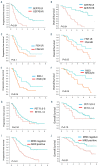Predicting risk of progression in relapsed multiple myeloma using traditional risk models, focal lesion assessment with PET-CT and minimal residual disease status
- PMID: 34847659
- PMCID: PMC8634177
- DOI: 10.3324/haematol.2021.278779
Predicting risk of progression in relapsed multiple myeloma using traditional risk models, focal lesion assessment with PET-CT and minimal residual disease status
Figures

Similar articles
-
Imaging minimal residual disease evaluation in multiple myeloma using [18F]FDG PET/MRI.Leuk Lymphoma. 2023 Feb;64(2):503-506. doi: 10.1080/10428194.2022.2142053. Epub 2022 Nov 16. Leuk Lymphoma. 2023. PMID: 36382776 No abstract available.
-
Positron Emission Tomography (PET) Radiopharmaceuticals in Multiple Myeloma.Molecules. 2019 Dec 29;25(1):134. doi: 10.3390/molecules25010134. Molecules. 2019. PMID: 31905752 Free PMC article. Review.
-
PET with Fluorodeoxyglucose F 18/Computed Tomography as a Staging Tool in Multiple Myeloma.PET Clin. 2019 Jul;14(3):369-381. doi: 10.1016/j.cpet.2019.03.009. Epub 2019 Apr 12. PET Clin. 2019. PMID: 31084776 Review.
-
11C-acetate positron emission tomography is more precise than 18F-fluorodeoxyglucose positron emission tomography in evaluating tumor burden and predicting disease risk of multiple myeloma.Sci Rep. 2021 Nov 12;11(1):22188. doi: 10.1038/s41598-021-01740-2. Sci Rep. 2021. PMID: 34773054 Free PMC article.
-
Improved Detection of Minimal Residual Disease by 11C-Methionine PET/CT in a Young Patient With Unusual Extramedullary Presentation of Recurrent Multiple Myeloma.Clin Nucl Med. 2017 Feb;42(2):e130-e134. doi: 10.1097/RLU.0000000000001462. Clin Nucl Med. 2017. PMID: 27922862
Cited by
-
Prognostic value of 18F-FDG PET/CT in patients with relapsed multiple myeloma.Ann Hematol. 2024 Oct;103(10):4145-4153. doi: 10.1007/s00277-024-05888-5. Epub 2024 Jul 16. Ann Hematol. 2024. PMID: 39012517
References
-
- Kristinsson SY, Anderson WF, Landgren O. Improved long-term survival in multiple myeloma up to the age of 80 years. Leukemia. 2014; 28(6):1346-1348. - PubMed
-
- Schinke M, Ihorst G, Duyster J, Wasch R, Schumacher M, Engelhardt M. Risk of disease recurrence and survival in patients with multiple myeloma: a German Study Group analysis using a conditional survival approach with long-term follow-up of 815 patients. Cancer. 2020; 126(15):3504-3515. - PubMed
-
- Hillengass J, Usmani S, Rajkumar SV, et al. . International myeloma working group consensus recommendations on imaging in monoclonal plasma cell disorders. Lancet Oncol. 2019;20(6):e302-e312. - PubMed
Publication types
MeSH terms
Substances
Grants and funding
LinkOut - more resources
Full Text Sources
Medical

